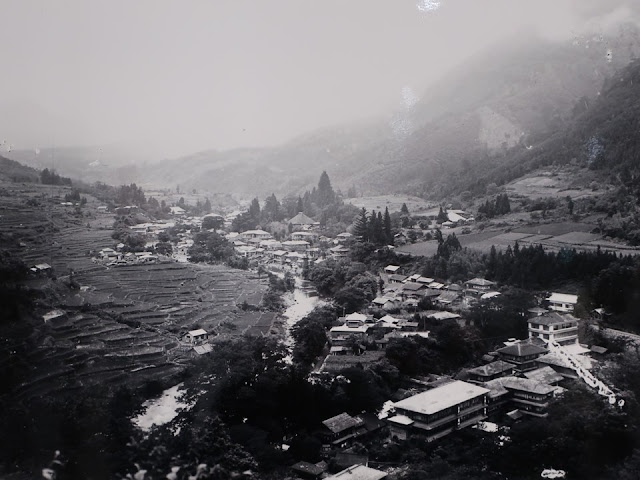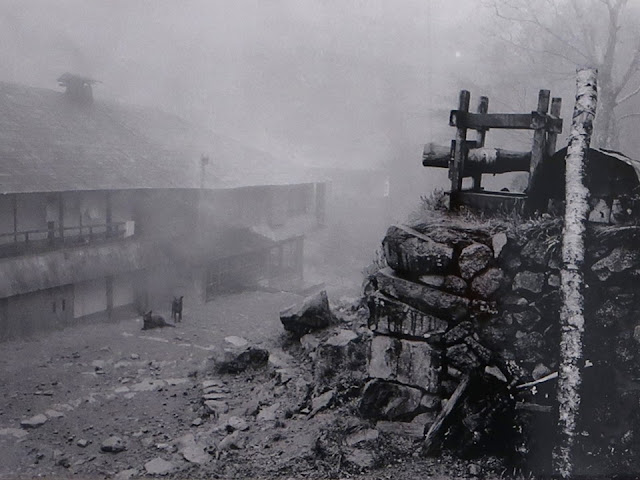Nasunogahara is a field at the foot of Mt. Nasu which is a volcano. It is popular as a summer resort and a hot spring resort. However, it was an uncultivated field of volcanic ash soil just 100 years ago.
The museum shows us the people’s history
including modern aristocrats. The special exhibition which displayed old photos
helped me to understand their lives.
那須岳の麓に広がる那須野が原は、今は避暑地や温泉リゾートとして人気です。しかし、明治までは、荒野でした。
ここでは、明治貴族も含めてこの地に生きた人々の歴史が展示されています。写真展示(企画展)が彼らの姿を伝えてくれます。
Special exhibition: Photos from the collection、企画展:収蔵資料の写真展示
Photos were well categorized.
生活のシーンに分けてこの地の写真が展示されています。
Pioneering、開拓
Aristocrats who funded the project and a pioneer family gather in front of the poor house. It was written that aristocrats’ passion to create a modern country and their longing for being like Western noble drove the cultivation work. But, I don’t like gentlemen who wear a hat.
開拓当時の民家。明治時代の貴族が、「近代国家建設の情熱と西欧貴族への憧れを胸に荒野の開拓に挑んだ」とパンフレットに書かれていました。でも、帽子をかぶった人達は嫌いだなあ。
Children、子どもたち
Children make us happy in all ages.
一番いいですね。子供は大切です。
The chic stroller has a bamboo basket.
乳母車がクラシック、というか竹かごです。
Kamishibai (picture-story show) gathers many children whose hairstyles are retro. It’s fun time.
お祭りにやってきた紙芝居(昭和)。観客が多いので、自転車ではなく、トラックの荷台に自転車を載せて演じています。坊ちゃん刈りとおかっぱ頭の時代ですね。
A bustle party is held under sakura cherry blossoms. They invite geisha girls who serve beer and play the shamisen guitar and the drum. Most of men hold a towel on around neck or head; it was usual in the early 20th century.
烏が森で花見(昭和初期)。芸者さんを呼んで、太鼓と三味線で大盛り上がりです。学生服の人もいます。手拭いを巻いている人が多いですね。
The Shiobara festival which was held in 1915 celebrated the enthronement of Taisho Emperor. The destination of the procession was the villa of the Emperor. The festival becomes a regular event after that. It’s a costume parade.
大正四年(1915)の塩原の祭り。大正天皇の即位を祝いました。この山車行列が、塩原温泉祭の始まりでした。みなさん、すごい仮装です。御用邸までお祝いに行ったそうですよ。
Livelihood、くらし
Photos and its utensils were exhibited together.
道具と共に写真が展示されています。
Working hard for his family
天秤棒を担いで売り歩く。生きてる、って感じがしませんか。
Onsen (hot-spring) resort、温泉街
Shiobara onsen resort; the terraced rice fields are developed into accommodation facility.
塩原温泉街。棚田は旅館になりました。
Shinyu onsen resort is behind Shiobara; it’s 1000m above the sea-level. There is a wooden four-story building, which has a retro taste.
There are Yunohana sheds near the fumarole at the slope of the mountain. “Yunohana” are mineral suspended solids in hot-spring water. We recover them and put them into a bathtub in our house. It literally means “flowers in hot water”.
塩原の奥の新湯(標高1000m)です。木造四階建て?、風情があります。山の斜面の噴気孔には、天然入浴剤の湯の花を採取する「湯の花小屋」があります。
This rustic onsen resort Itamuro is located in the mountain area. Many mountain worshippers used to visit there.
三斗小屋温泉(板室) ひなびていますが、会津中街道の湯治場で、白湯山信仰の登拝者でも賑わったそうです。行ってみたい。
Industry、産業
There were many lively photos.
ここにも生き生きとした写真がありました。初荷に集まった人々が元気です!
The first delivery of the year is a ceremony in the New Year’s. The shop ships charcoal by horse-carts. It’s taken in 1918.
正気屋の初荷(1918)。炭俵を積んだ馬車です。
The first delivery in the early 20th century; clerks wear hanten uniforms.
野州商会運送部の初荷(明治40年代)。揃いの半纏できめています。
The first delivery of soy sauce; everyone is pleased to ship and start their business in the New Year's.
醤油の初荷。みんな、品物を世に送り出す、商売をするのが嬉しいのですねえ。
The first delivery of the variety store “Yorozuya” in 1914; goods are put even on the stage on the roof. People including children celebrate the first shipping.
雑貨商「萬屋商店」の初売り(1914)。屋根に組まれた櫓の上にも商品が置かれていますよ。屋根の上に人がいるし、子どもたちもたくさんいて大賑わいです。
Rice planting in around 1916; women plant seedlings and men carry them. Many people just stand. I wonder whether a camera was rare.
田植え(1916頃)。女性が苗を植え、男性は苗を運びました。撮影のせいか、突っ立ている人も多いですねえ。
Packing of charcoal in around 1931. Those were major fuel of heating, cooking and so on.
炭の梱包(1931年頃)。主力の燃料でした。
Making bamboo baskets in 1950s; plastic material took over bamboo, but it may change to natural material again.
竹かご作り(昭和30年代)。プラスチックに取って代わられますが、天然材料にまた戻るかも。
Transportation、交通
Vehicles in the Showa period (1926-1989)
懐かしい昭和の乗り物
Young women surround the motorbike. It's in the early Showa period. Modernization finally comes to their village (it’s rude to say so, sorry). The owner must be popular with girls.
オートバイを囲む女性達(昭和初期/黒磯)。これですよ、これ。乗り物は人気だったのです。近代が来た、と言ったら失礼でしょうか。持ち主は持てたでしょうねえ。
Permanent exhibition、常設展示
Geographical features are explained at first, which is the dominant factor of the local history.
Mt. Nasu erupted again and again, and volcanic ashes covered the alluvial fan. Therefore, the water penetrates soon. People could not farm here.
キーである地形の説明から始まります。噴火でできた扇状地。水がすぐに地下に潜ってしまい、農業ができませんでした。
However, earthen goods were made in the Jomon period (more than three thousand years ago). The face is peaceful like a Buddhist statue. People could not get water easily, but they lived and made accessories.
でも、縄文時代の土器があります。仏様のようないいお顔です。水を得にくい土地でも人は住んで、土を焼いてアクセサリーなどを作っていました。
In 1885, the canal was constructed, and it became possible to cultivate the field.
那須に水をもってきた那須疎水。那須野が原を農地にできるようになりました。1885年(明治18年)のことでした。
Aristocrats worked on developing the Nasunogahara field.
那須野が原の開拓。明治貴族達が農場経営に乗り出しました。
Historical people and former Daimyo-lord Mouri clan owned farms.
西原の農場主には、松方正義、大山巌、西郷従道らの名があります。東原の開拓には、毛利家の名もあります。
On the other hand, pioneers struggled with getting water, strong wind and stones under the ground.
一方、人々の暮らしは厳しい。水・風・石との戦いでした。ボタンを押すと音声が流れ、ジオラマの中の人達が生活を語ってくれます。
There was no floor in a pioneer’s house at the beginning. People spread leaves and straws on the ground. It was same as 600 years ago, so difficult.
開拓地の家。開拓当初は、床がなく、土間に木の葉や藁を敷いて暮らしたそうです。室町時代の家と同じです。厳しい。
Emperor’s villa and aristocrats’ farms、「華族農場と塩原御用邸」
Many photos of villas were exhibited at the hall.
ホールでは、今も残る豪華な別荘の写真が展示されていました。
The photo above is about the villa of Masayoshi Matsukata who was a prime minister. He interacted with Western aristocrats and billionaires, so he knew their country houses. He was engaged in developing the field from the beginning.
I’m not sure whether the life at the
luxurious villa pleased them. Fun would be found even in an ordinary daily
activity, I think.
いやはやとしか、言いようがない別荘ですね。欧米を貴族や富豪と付き合いのあった元首相の松方ならではですね。那須野が原の開拓には、明治貴族たちが最初から参画しました。彼らは、欧州の貴族の田園地での別荘を知っていました。
でも、豪華な別荘での毎日が楽しかったのかどうか、それは別問題ですね。
Visited in November, 2020
Official website: http://www2.city.nasushiobara.lg.jp/hakubutsukan/
(in Japanese), accessed in September, 2021
Previous post (exhibits about the meal history are excellent):
MAHORON(Fukushima Cultural Property Centre,
Shirakawa Branch)、まほろん(福島県文化財センター・白河館)
Next post (book
about holidays around two hundred years ago):
Village holidays in the Edo period、村の遊び日





































Comments
Post a Comment